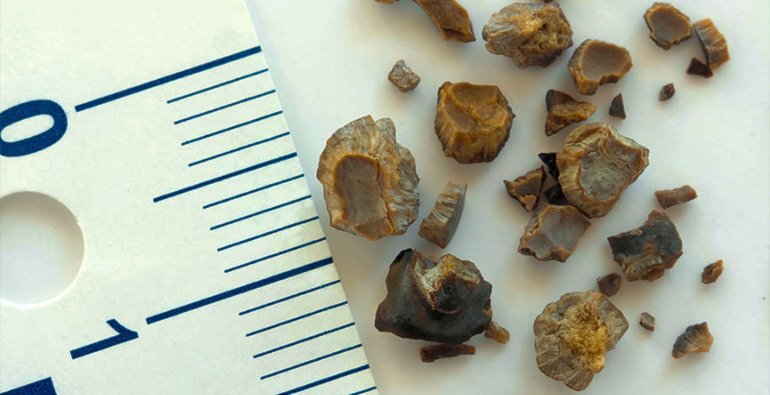Kidney stones, also known as renal calculi, can be extremely painful.
The pain of passing a kidney stone is sometimes compared to that of childbirth, which is rated as one of the most painful experiences {1, 2}.
So what are kidney stones, why do they form, and what are their symptoms and risk factors?
This article explains all you may need to know about kidney stones…
Understanding Kidney Stones
Kidney stones are solid masses made from certain chemicals in the urine. They generally form in the kidneys, however, they can also form anywhere in the urinary tract.
Kidney stones develop when the urine contains a high concentration of stone-forming substances and too little liquid that can prevent these substances from sticking together. The stone-forming substances are calcium, oxalate, urate, cystine, xanthine, and phosphate.
Kidney stones vary in size, shape and colour and are named differently based on the substances they are made of.
According to the National Health Service, kidney stones can form in one or both kidneys and often affect people aged 30 to 60.
Note that men are 2 to 3 times more likely to develop kidney stones, compared with women {3, 4, 5}.
If you’ve already had a kidney stone, your risk of getting another is said to be around 50 per cent within 5 years {6, 7, 8}.
Prevalence
Epidemiologic studies show us that the prevalence rate of kidney stones is increasing around the world {6, 9}.
More than half a million people in the US visit emergency rooms every year due to kidney stones, says the National Kidney Foundation.
It is thought that 1 in 10 people will develop a kidney stone at some point in their lives {6, 10, 11}.
Causes and Risk Factors
Kidney stones often have no single cause; several factors may increase the risk of forming a kidney stone.
Risk Factors for Kidney Stones include:
- Insufficient Liquid Intake: Not drinking enough water (dehydration) can significantly increase the risk of developing kidney stones. Because when the urine lacks fluid, certain substances can stick together and form kidney stones.
- Gender: If you are a man you are 2 to 3 times more likely to form a kidney stone compared to a woman, as mentioned above.
- Living in dry climates: Living or working in dry and hot climates can increase sweating, thus reducing the amount of fluid in the body. And that in turn can cause the urine to be more concentrated, allowing substances to stick together and form kidney stones.
- Family and Personal History: Kidney stones tend to run in families. If you have a family member who has had kidney stones, you may be at increased risk. Moreover, if you’ve had kidney stones before, your risk of developing another is high.
- Obesity: Studies show that obesity and weight gain increase the risk of kidney stone formation.
- Certain Diets: A diet high in protein, sodium and sugar is known to increase kidney stone risk.
- Some Diseases and Surgery: Some digestive diseases such as chronic diarrhoea, and surgeries such as gastric bypass can increase kidney stone risk. Note that kidney stones are more common in people with type 2 diabetes.
- Certain supplements and medications; such as vitamin C, laxatives (when used excessively), calcium-based antacids, and certain drugs prescribed for migraines and depression may increase your risk of forming kidney stones.
Types of Kidney Stones
There are 4 main types of kidney stones. They are named based on the substances that they are made of.
Knowing the type of kidney stone you have can help you reduce the risk of developing another.
Calcium Stones
Calcium stones are by far the most common type of kidney stones, constituting approximately 80% of all kidney stone cases. They are often made of calcium and oxalate, called calcium-oxalate stones {12, 13}.
Reducing the intake of foods high in oxalates such as almonds (almond milk), cashews, rhubarb, spinach and potato chips can help reduce the risk of forming calcium-oxalate stones {14, 15}.
Uric Acid Stone
Uric acid stones occur when urine gets too acidic. This kind of kidney stone is the second most common type, after calcium stones {16, 17, 18}.
Eating a diet rich in purines — a substance found in animal proteins such as fish, shellfish and meats — can increase urine’s acidic level {19, 20}.
The formation of uric acid stones tends to run in families {19, 21}.
Struvite Stone
This type of stone is caused by an infection in the upper urinary tract. Struvite stone is less common compared to calcium and uric acid stones {22, 23}.
Cystine Stones
Cystine stones are very rare and tend to run in families. This kind of stone occurs in people with cystinuria, a genetic disorder {22, 24}.
According to the National Kidney Foundation; cystine stones often reoccur and are generally larger compared to other types of kidney stones.
Symptoms
Very small kidney stones can leave your body through your urine without causing any pain.
However, if a stone becomes large or moves down to the ureter — a tube that carries urine from the kidney to the bladder — you may have some symptoms.
Symptoms of a kidney stone include:
- Pain in your lower back or side of your body (pain comes and goes and can be intense )
- Frequent need to urinate
- Being unable to urinate
- Feeling pain when peeing
- Foul-smelling urine
- Blood in the urine (red, pink, or brown urine)
- Fever and chills
- Vomiting, nausea
Treatment Options
Treatment for kidney stones depends on several factors, including the size, type and location of the stone {25, 26}.
If the stone is small it may pass through your urinary tract. Remember that small stones may also cause pain when you pass them.
To ease your symptoms and pain, your doctor may advise you to:
- drink plenty of water
- use certain pain relievers
- use alpha-blockers (medicines to help the stone pass with ease and with less pain)
If the stone is large it may not pass naturally and block your urinary tract and thus may cause severe pain. In these circumstances, extensive treatment (surgery) might be required {25, 27, 28}.
The main types of surgery for removing kidney stones include:
- Shock wave lithotripsy: A procedure that uses sound waves to create strong vibrations to break the stones into tiny pieces so that can be passed in your urine.
- Ureteroscopy: Involves using a thin lighted tube called ureteroscope. The surgeon inserts it through the ureter to retrieve the stone or break it into pieces that can be passed in your urine.
- Percutaneous nephrolithotomy: Involves using a telescopic instrument called a nephroscope. The surgeon makes a small incision in your back and inserts the nephroscope directly in your kidney to remove or break the stone into pieces.
Kidney Stones Prevention
There are several ways to reduce your risk of developing a kidney stone.
- Drinking enough fluid is the first line of defence against kidney stones. Fluid will keep your urine less concentrated, reducing the risk of forming a stone. Aim for 12 glasses of water each day, unless your doctor tells you otherwise.
- Limiting salt consumption can help reduce the risk. This is because sodium increases the amount of sodium in the urine.
- Eating more vegetables and fruits will make your urine less acidic, helping to prevent the formation of kidney stones.
- Losing weight or maintaining a healthy weight can significantly reduce the kidney stones risk.
- Working with your doctor, as always, is the best way to manage a condition. If you have a kidney stone, work with your doctor closely. You may be prescribed a medication.
Tarkan is an experienced health writer ( currently more than 600 articles ) and also the founder of this website namely www.neededforhealth.com. His expertise in health stems from in-depth medical research and knowledge which he obtained over the course of many years.
Tarkan enjoys sharing factual knowledge on health, psychology and nutrition. He always aims to deliver evidence-based recommendations, provide links to related scientific studies.

